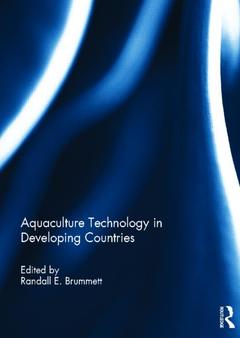Aquaculture Technology in Developing Countries
Coordonnateur : Brummett Randall E.

Aquaculture technology has been evolving rapidly over the last two decades, led by an increasingly skilled cadre of researchers in developing countries. Rather than copying, or adapting work done in industrialized countries to their situations, these scientists are moving aquaculture research out of the box to explore species and production systems relevant to their natural resources, economies and social institutions.
Studies from India, Latin America, the Middle East and Africa are highlighted in this collection of papers, covering the entire gamut of aquaculture science from comparison of tilapia breeds, novel feed ingredients for indigenous species, improving disease resistance, water-use efficiency, traditional farming systems, spatial planning and economics. More than a how-to book, this volume introduces the researchers and institutions leading the development of aquaculture as it expands into new frontiers.
This book was based on a special issue of the Journal of Applied Aquaculture.
1. Overview Africa (policy and production systems) 2. Constraints in Accessing Credit Facilities for Rural Areas: The Case of Fish Farmer’s in Rural Morogoro, Tanzania 3. The traditional whedo aquaculture system in northern Benin 4. Production parameters and economics of small-scale tilapia cage aquaculture in the Volta Lake, Ghana 5. Impacts of Aquaculture Development Projects in Western Cameroon 6. Rearing rabbits over earthen fish ponds in Rwanda: effects on water and sediment quality, growth and production of Nile tilapia Oreochromis niloticus Middle East (water efficiency) 7. Improving Water Use Efficiency in Semi-Arid Regions through Integrated Aquaculture/Agriculture 8. Growth Performance of Improved (EXCEL) and a Non-Improved Strains of Oreochromis niloticus fry in a recirculating tank system in the UAE 9. Use of underground brackish water for reproduction and larviculture of rainbow trout, Oncorhynchus mykiss 10. The use of American ginseng in practical diets for Nile tilapia: growth performance and challenge with Aeromonas hyrdophila. Latin America (indigenous species) 11. Use of spray-dried blood meal as an alternative protein source in pirarucu (Arapaima gigas) diets 12. Effect of density on growth and feeding of the crayfish Cambarellus montezumae. 13. Growth of juvenile crayfish Procambarus ilamasi fed different farm and aquaculture commercial foods 14. Survival of diploid and triploid Rhamdia quelen juveniles under different oxygen concentrations. 15. Effect of stock density and ploidy in jundia, Rhamdia quelen, larva performance Asia (environment) 16. Integrated Fish Farming for Nutritional Security in Eastern Himalayas, India 17. Waste Water Aquaculture by the Mudialy Fisherman’s Cooperative Society in Kolkata, West Bengal - An example of Sustainable Development 18. The effect of partial replacement of dietary fishmeal with fermented prawn waste liquor on juvenile sea bass growth 19. Growth performance and resistance to Streptococcus of juvenile Nile tilapia fed diets with Grobiotic-A and Brewtech dried brewers yeast 20. Accumulation and Clearance of Orally Administered Erythromycin in Adult Nile Tilapia (Oreochromis niloticus) and Giant Freshwater Prawn (Macrobrachium rosenbergii)
Randall E. Brummett is the Senior Aquaculture Specialist at the World Bank and the Academic Editor of the Journal of Applied Aquaculture. He spent 30 years doing research for aquaculture development in Africa and the Middle East.
Date de parution : 09-2013
17.4x24.6 cm
Disponible chez l'éditeur (délai d'approvisionnement : 14 jours).
Prix indicatif 160,25 €
Ajouter au panierThèmes d’Aquaculture Technology in Developing Countries :
Mots-clés :
Research for Development; Sustainable Aquaculture; Proximate Body Composition; Maja Brachydactyla; Lethal Concentration; Juvenile Nile Tilapia; Integrated Fish Farming; Accessing Credit Facilities; Cirrhinus Mrigala; Prawn Waste; Nile Tilapia; Catla Catla; Recirculating Aquaculture System; Rhamdia Quelen; MRS Broth; Giant Freshwater Prawn; Sea Bass; Serum Lysozyme Activity; Growth Performance Indicators; Rainbow Trout; Streptococcus Iniae; Initial ABW; Fish Effluent; Pagrus Auratus; Agglutinating Antibody Titer; Juvenile Sea Bass; Head Kidney Macrophages



